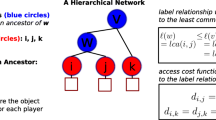Abstract
In this paper, we propose a new structured P2P overlay network, named SW-Uinta(small-world). In order to reduce the routing latency, we firstly construct the Uinta network in which both physical characteristics of network and data semantic are considered. Furthermore, based on Uinta, a nondeterministic caching strategy is employed to allow for poly-logarithmic search time while having only a constant cache size. Compared with the deterministic caching strategy proposed by previous P2P systems, the nondeterministic caching strategy can reduce communication overhead for maintaining the routing cache table. Cache entries in the cache table of peer nodes can be updated by subsequent queries rather than only by running stabilization periodically. In the following, a novel cache replacement scheme, named the SW cache replacement scheme, is used to improve lookup performance, which has proved to satisfy the small-world principle. So we call this network SW-Uinta(small-world). After that, according to the theoretical analysis, it can be proved that SW-Uinta(small-world) can get O((log 2 N)/k) search time with O(k) cache size. Lastly, the performance of SW-Uinta(small-world) is compared with those of other structured P2P networks such as Chord and Uinta. It shows that SW-Uinta(small-world) can achieve improved object lookup performance and reduce maintenance cost.
Similar content being viewed by others
References
Gnutella Website. http://www.gnutellaforums.com/
Leibowitz N, Ripeanu M, Wierzbicki A (2003) Deconstructing the Kazaa network. In: Proceedings of 3rd IEEE workshop on Internet applications, Santa Clara, CA, pp 112–120
Clarke I, Sandberg O, Wiley B et al (2000) Freenet: A distributed anonymous information storage and retrieval system. In: Proceedings of workshop on design issues in anonymity and unobservability, ICSI, pp 311–320
Stoica I, Morris R, Karger D, Kaashoek MF, Balakrishnan H (2001) Chord: a scalable peer-to-peer lookup service for Internet applications. In: Proceedings of the ACM SIGCOMM. ACM Press, New York, pp 149–160
Ratnasamy S, Francis P, Handley M, Karp R, Shenker S (2001) A scalable content-addressable network. In: Proceedings of ACM SIGCOMM. ACM Press, New York, pp 161–172
Rowstron A, Druschel P (2001) Pastry: scalable, distributed object location and routing for large-scale peer-to-peer systems. In: Proceedings of the 18th IFIP/ACM international conference on distributed systems platforms. Springer, Berlin, pp 329–350
Zhao BY, Huang L, Stribling J, Rhea J, Joseph SC, Kubiatowicz AD (2004) Tapestry: a resilient global-scale overlay for service deployment. IEEE J Sel Areas Commun 22:41–53
Ratnasamy S, Handley M, Karp R et al. (2002) Topologically-aware overlay construction and server selection. In: Proceedings of IEEE INFOCOM’02. IEEE Press, New York, pp 1190–1199
Mahanti A (1999) Web proxy workload characterization and modeling. Master’s thesis, Department of Computer Science, University of Saskatchewan, September 1999
Milgram S (1967) The small world problem. Psychol Today 2:60–67
Watts D, Strogatz S (1998) Collective dynamics of small-world networks. Nature 393:440–442
Kleinberg J (2002) Small-world phenomena and the dynamics of information. In: Proceedings of advances in neural information processing systems. MIT Press, Cambridge, pp 14–25
Kleinberg J (2000) The small-world phenomenon: an algorithmic perspective. Technical Report, Cornell Computer Science
Iamnitchi A, Ripeanu M, Foster I (2004) Small-world file-sharing communities. In: Proceedings of IEEE INFOCOM. IEEE Press, New York, pp 175–186
Maymounkov P, Mazieres D (2002) Kademlia A peer-to-peer information system based on the xor metric. In: Proceedings of the 1st international workshop on peer-to-peer systems (IPTPS’02), Cambridge, MA, pp 53–65
Malkhi D, Naor M, Ratajczak D (2002) Viceroy: a scalable and dynamic lookup network. In: Proceedings of the 21st ACM symposium on principles of distributed computing PODC’02, Monterey, CA, pp 183–192
Manku GS, Bawa M, Raghavan P (2003) Symphony: distributed hashing in a small world. In: Proceedings of the fourth USENIX symposium on Internet technologies and systems (USITS), Seattle, WA, pp 127–140
Roussopoulos M, Baker M (2003) CUP: controlled update propagation in peer-to-peer networks. In: Proceedings of the 2003 USENIX annual technical conference
Garces-Erice L, Ross KW, Biersack EW, Felber PA, Urvoy-Keller G (2003) Topology-centric look-up service. In: Proceedings of COST264/ACM fifth international workshop on networked group communications (NGC), Munich, Germany. Springer, Berlin
Harvey NJA, Theimer M, Jones MB, Sarouiu S, Wolman A (2003) Skipnet: a peer-to-peer overlay network. In: Proceedings of the fourth USENIX symposium on Internet technologies and systems
Freedman MJ, Freudenthal E, Mazières D (2004) Democratizing content publication with coral. In: Proceedings of USENIX/ACM symposium on networked systems design and implementation (NSDI’04), San Francisco, CA
Gummadi K, Gummadi R, Gribble S, Ratnasamy S, Shenker S, Stoica I (2003) The impact of DHT routing geometry on resilience and proximity. In: Proceedings of ACM SIGCOMM
Karger DR, Lehman E, Leighton F et al (1997) Consistent hashing and random trees: distributed caching protocols for relieving hot spots on the world wide web. In: Proceedings 29th annual ACM symposium theory of computing, El Paso, TX, pp 654–663
Kubiatowicz J, Bindel D, Eaton P et al ( 2000) OceanStore: an architecture for global-scale persistent storage. In: Proceedings of the 9th international conference on architectural support for programming languages and operating systems (ASPLOS’00), Cambridge, MA, pp 190–201
Dabek F, Frans Kaashoek M, Karger D et al (2001) Wide-area cooperative storage with CFS. In: Proceedings of the 18th ACM symposium on operating systems principles (SOSP’01), Banff, Alberta, Canada, pp 202–215
Zhang H, Goel A, Govindan R (2002) Using the small-world model to improve Freenet performance. In: Proceedings of IEEE INFOCOM 2002. IEEE Press, New York, pp 1228–1237
Zegura EW, Calvert K, Bhattacharjee S (1996) How to model an Internet work. In: Proceedings of the 15th annual joint conference of the IEEE computer and communications societies (INFOCOM’96). IEEE Communications Society, San Francisco, pp 594–602
Author information
Authors and Affiliations
Corresponding authors
Additional information
This paper is supported by National Science Foundation of China under Grant 60433040, and CNGI projects under Grants CNGI-04-12-2A and CNGI-04-12-1D.
Rights and permissions
About this article
Cite this article
Xu, J., Jin, H. A structured P2P network based on the small world phenomenon. J Supercomput 48, 264–285 (2009). https://doi.org/10.1007/s11227-008-0219-8
Received:
Accepted:
Published:
Issue Date:
DOI: https://doi.org/10.1007/s11227-008-0219-8




